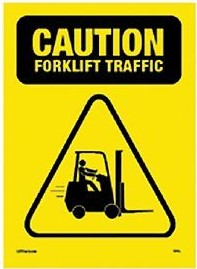Effectively labeling your distribution center with safety signage can prevent injuries and is an OSHA demand. Not only can it prevent or at least minimize injury to personnel, it can minimize downtime and workers’ compensation claims and fines.

Making your facility injury free starts with a safety inspection and evaluation of all operations, equipment and workspace.
This should be done with a mind on general industry compliance. That would include:
• General Safety
• Identification of Piping
• Electrical Equipment
• Emergency Preparedness
• Hazardous Chemicals
• Lean Manufacturing
• Floor Marking
• Label Placement And Visual Solutions
General Safety
When it comes to distribution centers, one size does not fit all. Each facility is unique with its own needs and limitations. Still, having a safe working environment is essential. To ensure general safety, all personnel must understand the message that safety signage communicates. OSHA helps with what safety signs to use and where to put them. Moreover, these signs display specific designs in accordance with OSHA and ANSI regulations. For more assistance view OSHA’s Best Practice Guide to Safety Signs.
Identification of Piping
To ensure against injury due to obstructions such as piping systems, it is essential that all pipes and piping components be marked with a sign. Such signs will not only alert personnel to the physical obstruction, but also notifies about the hazard contained in the pipes. Clear labeling can increase safety and efficiency during maintenance and pipe system shutdown procedures. Meet ANSI/ASME standards for pipe marking with the Best Practice Guide To Pipe Marking.
Electrical Equipment
Electrical equipment is a vital part of any structure and it is imperative that such equipment is safe, General electrical safety requirements is so essential, it is one of OSHA’s top 10 most frequently cited violations each year. OSHA regulations require that electrical hazards including control panels and components be clearly labeled. Your facility must display signs that note voltage ratings, arc flash warning, electrical clearances, as well as safety procedures including lockout and tag out. Although it is true that each workplace is different, you can customize electrical signs and identification labels. However, the signs must still comply with regulations. For help, check out Guide to Control Panel Labeling.

Emergency Preparedness
Be sure that your facility is prepared for a potential disaster. Effective planning and preparation that minimize losses is essential. So post key emergency signage and markings throughout your facility so that personnel know what to do when a disaster strikes. Create checklists so that you can regularly keep up with your facility’s needs when preparing for disasters and take steps to assure that everyone understands the OSHA-required Emergency Action Plan.
Hazardous Chemicals
If your facility stores hazardous chemicals, then educate your personnel on how to use them and what procedures to take in case of a chemical spill. Identify all hazardous chemicals present and clearly label them in accordance with OSHA’s preferred labeling, which is based on the International GHS system. Make certain that personnel are familiar with sections of GHS Labeling and know how to create chemical labels that comply with the standards.
Lean Manufacturing
Ensure that your day-to-day operations are organized to enhance workplace efficiency. This can be achieved by installing signage that give workers clear and accurate identification of locations, equipment, procedures, hazards, inventories and tools.
Floor Marking
OSHA requires that you perform periodic inspections of walkways and surfaces to assure that they are clean, safe, and accessible. Clear and consistent markings help assure proper traffic flow. Use floor signs to identify work zones and aisles, and to alert personnel to hazardous areas.
Label Placement and Visual Solutions
Signs and labels should be placed so that they are clearly visible and legible. To ensure that signs and labels are read and understood:
• Place them at eye-level.
• Color-code them so that they can be recognized from a long distance.
• Use floor signs in hard-to-label areas.
It is suggested that you perform an evaluation of the workspace on a periodic basis to discover new hazards and conditions that need signage. Also make certain during your walk through that old signs are legible and accurate.
(Source: mmh.com)

